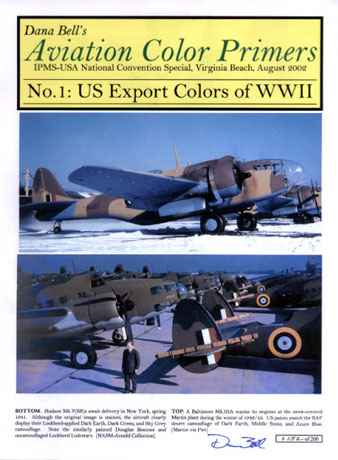|
Aviation Color Primers
Nº 1 - US Export Colors
of WWII
by Dana Bell
S u m m a r y
|
| Media: |
Soft cover; A4 format; full
colour |
| Price: |
TBA (Available
from Meteor Productions |
| Review Type: |
First Read |
| Advantages: |
Excellent coverage of early war
US export colors plus an analysis of the standards and their haphazard
implementation. |
| Disadvantages: |
|
| Recommendation: |
Highly Recommended |
Reviewed by Fernando
Rolandelli

HyperScale is proudly sponsored by Squadron.com
 There
was a time when all USAAF aircraft were either painted in Olive Drab and
Neutral Grey or left Natural Metal (if coming from a late war period), and
we modelers were happy. Well, it seems we should not have been, for
someone realized that there had always been some P-40s (the famed Flying
Tiger’s, for example) and P-39s (later we discovered that they were
actually P-400s) going around sporting odd disruptive camouflage schemes.
The reason behind this incongruence lies in the fact that many USAAF
aircraft in the very early war period were drawn from foreign orders and
impressed into service, thus having the scheme required by the initial
customer. On the other hand, given the great quantity of American made
aircraft supplied to the Allies, the question of their camouflage colors
becomes crucial to the modeler. There
was a time when all USAAF aircraft were either painted in Olive Drab and
Neutral Grey or left Natural Metal (if coming from a late war period), and
we modelers were happy. Well, it seems we should not have been, for
someone realized that there had always been some P-40s (the famed Flying
Tiger’s, for example) and P-39s (later we discovered that they were
actually P-400s) going around sporting odd disruptive camouflage schemes.
The reason behind this incongruence lies in the fact that many USAAF
aircraft in the very early war period were drawn from foreign orders and
impressed into service, thus having the scheme required by the initial
customer. On the other hand, given the great quantity of American made
aircraft supplied to the Allies, the question of their camouflage colors
becomes crucial to the modeler.
This is the subject dealt by Dana Bell, of Squadron Signal Publications
fame, in his booklet “Aviation Color Primers: N° 1: US Export Colors of
WWII”. It is small (20 pages in all), neatly computer-printed in black and
white, except the covers (in higher-grade paper) showing quite interesting
color photos from the period, all stapled three-fold. It is a sort of
limited-edition, thus each copied is individually numbered (mine is n° 152
out of 200).
The monography deals with the painting of American military aircraft bound
to the export market in the immediate prewar, through the early war
period. It begins by loosely describing the schemes used in the aircraft
ordered by the British Aircraft (Purchasing) Commission directly to
American manufacturers in the neutrality days, before the Lend-and-Lease
program, and which were, of course, painted to British specifications in
the most feasible way, even before the USAAC required its own machines to
be camouflaged, as well as the commands made by other customers, specially
the French and the Dutch.
But the real hard core of the article is formed by the analysis of the
acts of the Technical Sub-Committee on Camouflage, formed on 13 February,
1942, and charged with the not mean task of the standarization of the
camouflage paints required not only by the US Army and Navy, but the
British RAF and Fleet Air Arm as well. From the works of this committee
emerged the color and paint specifications now known as the “ANA”, the
standard joint Army-Navy camouflage colors. Even parts of the actual acts
text are transcribed. They go a long way to explain how the early colors
used in a fairly haphazardous way were merged into the ANA specs, which of
them “survived” and which were discarded. Problem is that the monograph
limits itself to “official” data and information, with little concern
about the actual practices of the factories themselves (with a major
exception made when dealing with the problem of Curtiss’ Dark Earth as
seen on P-40s).
Written accounts are complemented with black-and-white photos, all of them
interesting and to-the-point, such as the one showing Olive Drab and
camouflaged P-47s sharing the same production line! Several drawings,
taken from original official blueprints, show annotated camouflaged
schemes of assorted aircraft.
The monograph is somewhat lacking in that it does not include reference to
any commercially available color range, such as Pantone or Munsell, to the
RGB system nor to any actual modeling paint range, all of them useful
shortcuts to the modeler. This is not within its scope, so it cannot be
taken as a fault on its part. The monograph intends to provide a solid,
well researched reference to the official colors used in the different
camouflage schemes, but not the actual physical look of them, nor to the
evolution of them into, say, the FS 595a specifications. It successfully
helps get rid of many misconceptions and long surviving “myths”
surrounding this important subject.
The conspicuous “N° 1” in the monograph’s title makes us hope for a follow
up. May it be on the fascinating saga of the Dark Olive Drab / Olive Drab
/ ANA 613 color, barely hinted in the text.
This booklet is highly recommended to back up polemic schemes and
positions in experts’ arguments. Polemic is no longer restricted to
late-war Luftwaffe’s fighter schemes!
Highly
Recommended
Review Copyright © 2003 by Fernando Rolandelli
This Page Created on 12 January, 2003
Last updated
24 August, 2003
Back to
HyperScale Main
Page
Back to
Reviews Page |
Home | What's
New | Features
| Gallery |
Reviews | Reference
| Forum
| Search